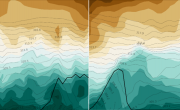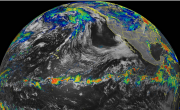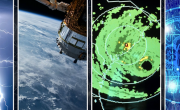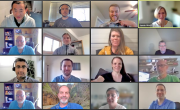Spring 2022 | Randy Pierce is a NOAA partner whose software engineering talent supports METexpress. His software engineering role was inspired by his love of detail, building things, and an early curiosity about engineering. From the beginning, he always had a passion for understanding how things work. He earned a dual bachelor's degree in physics and electrical engineering technology from Colorado State University Pueblo… Read More
Bridges to Operations: Physics Assessments in Support of the Upcoming GFS and GEFS 2024 Implementations

Spring 2022 | The next operational implementations of the Global Forecast System (GFS) and Global Ensemble Forecast System (GEFS) are not scheduled until 2024, but work is underway to code and test a number of upgrades to these modeling systems. While innovations are planned in all aspects of the end-to-end system, the DTC has been particularly involved in supporting the development and improvement of the physics suite as a member of the Unified Forecast System (UFS) Research-to-Operations (R2O)… Read More
Visitors: From Innovations to Operations, the DTC Visitor Program Stimulates Progress
Visitor Program: An Overview

Spring 2022 | Since 2004, one of the hallmarks of the Developmental Testbed Center (DTC) has been its visitor program. The DTC Visitor Program provides an opportunity for DTC staff and our operational partners to strengthen ties with the research community, which is critical to the success of the DTC’s mission. It began informally when four scientists were invited to work with us for one month over the summer on a project of their choice. The only stipulation was that it had to be consistent with… Read More
Community Connections: The GeneralIzed Aerosol/chemistry iNTerface (GIANT)
Workshop and Hackathon

Spring 2022 | An Earth System Model (ESM) is a model that represents various domains of the earth, such as atmosphere, ocean, sea ice, etc. A new community effort is underway to devise a method to transfer information easily and consistently between chemistry and aerosol modules, and other components of ESMs. Currently, it is difficult to study and quantify feedbacks of chemistry/aerosol parameterizations on weather and climate because of the structurally diverse ways in which chemistry/aerosols… Read More
Did you know?: New US Council for Interagency Coordination of Meteorological Service
Spring 2022 | In April 2017, the President signed into law the Weather Research and Forecasting Innovation Act. This Act required establishing an Interagency Committee for Advancing Weather Services -- The Interagency Council for Advancing Meteorological Services (ICAMS) meets this requirement. ICAMS serves to improve… Read More
Announcement: 2022 DTC METplus Workshop Registration and Call for Abstracts Open

2022-04-12 | Calling All METplus Enthusiasts! The DTC is hosting the first ever METplus Users Workshop. The goals of the workshop include building the METplus community and empowering users to contribute to the development of and planning for the verification and diagnostic framework. It is planned for 27-29 June 2022 and will be hosted virtually. Participation is free. Here's some pertinent details: Tentative Schedule: Call for Abstracts: 20 April - 20 May Monday, 27 June: 8:30am-2:30pm MT (10:30am-4:30pm ET; 1430-2030 UTC) Tuesday… Read More
Software Release: Containerized NWP System Version 4.0.0 Release

2022-03-29 | The Developmental Testbed Center (DTC) is pleased to announce the release of version 4.0.0 of their end-to-end containerized numerical weather prediction (NWP) system. These software containers have been established for community use to quickly spin up an NWP forecast system [using the WRF Pre-Processing System (WPS), Weather Research and Forecasting (WRF) model, and Gridpoint Statistical Interpolation (GSI) data assimilation] that can then be post-processed [using the Unified Post Processor (UPP)] and verified [using… Read More
Software Release: METplus v4.1.0 Coordinated Release

2022-03-15 | The DTC is pleased to announce the release of the multi-component verification framework called the enhanced Model Evaluation Tools (METplus), or METplus. METplus contains a suite of Python wrappers and ancillary scripts to enhance the user's ability to quickly set-up and run MET. METplus also has an analysis suite including METviewer and METexpress user interfaces and METdatadb, METcalcpy, and METplotpy as shared packages for loading and storing MET output as well as aggregating and… Read More
Lead Story: Engaging Forecast Community in UFS Model Development: UFS Forecasters Workshops 2020-21

Winter 2022 | With the advent of the Unified Forecast System (UFS), the operational model development at the National Weather Service (NWS) is increasingly becoming a collective effort that includes contributions from multiple NOAA labs, national agencies, and university research groups. The NWS forecasters are the primary stakeholders of the UFS’ operational forecast products, and therefore, continued engagement with them is important for staying abreast of the real-world performance of the model… Read More
Director's Corner: DTC Transferal of Code, and Certain Tasks and Responsibilities to EPIC
Bill Mahoney

Winter 2022 | The DTC is at an interesting pivot point in its 19-year history as it has the opportunity to redirect its efforts back to its original imperative of advanced numerical weather prediction (NWP) testing and evaluation. This opportunity is due to the establishment of the Earth Prediction Innovation Center (EPIC). As stated in the DTC charter, “The DTC was initiated in 2003 as a means for the NWP community… Read More
Who's Who: Julie Prestopnik
Winter 2022 | Julie and her older brother grew up in South Florida. She worked her way through high school and part of college as a cashier at Publix Super Markets. She earned her college degree in accounting from the University of Central Florida (UCF). During her college years, she started working for the accounting department at the UCF Foundation, and by her senior year, she had earned a prestigious internship with Coopers and Lybrand.… Read More
Bridges to Operations: A Comprehensive Retrospective Evaluation of the Global Synthetic Weather Radar Products Using METplus

Winter 2022 | Traditional radar product integrity suffers from gaps in coverage over large areas. While some geographical areas are fortunate to have ground- and/or satellite-based radar coverage, most areas around the globe do not have complete coverage from reliable radar networks. The use of radar-based products is advantageous for understanding current weather conditions and how weather systems may evolve over time. Convection and precipitating weather systems often… Read More
Visitors: Physics Process-based Evaluation of the Hurricane Vortex Structure and Size of Tropical Cyclones in HAFS
Visitor: Shaowu Bao

Winter 2022 | The Hurricane WRF (HWRF) has been the US operational hurricane forecast model since 2007. The Hurricane Forecast and Analysis System (HAFS), based on the GFDL Finite-Volume Cubed-Sphere Dynamical Core (FV3), a scalable and flexible dynamical core, is the likely candidate to replace the operational HWRF. HAFS is the focus of a Unified Forecast System - Research to Operations (UFS-R2O) hurricane modeling project and the next generation hurricane forecast system.… Read More
Community Connections: UFS SRW Application Training: The Wrap Up

Winter 2022 | Supporting the development of the Unified Forecast System (UFS) has been a central focus of the DTC for several years now. Many staff have concentrated on support, development, and training of this new state-of-the-art system that bridges the gap between the research and operational communities. In September 2021, we… Read More
Did you know?: DTC Visitor Program accepting applications
Winter 2022 | Despite the challenges of COVID, the DTC Visitor Program is thriving. With the incremental opening of NCAR facilities, some visitors have been working on site, while others have been collaborating with DTC staff remotely. We invite researchers to apply to the program as an opportunity to collaborate with us on a diverse range of exciting projects. Our program has hosted visitors who have made cutting-edge enhancements to DTC software and tools, model improvements, innovated… Read More
Pagination
Copyright © 2025. All rights reserved.